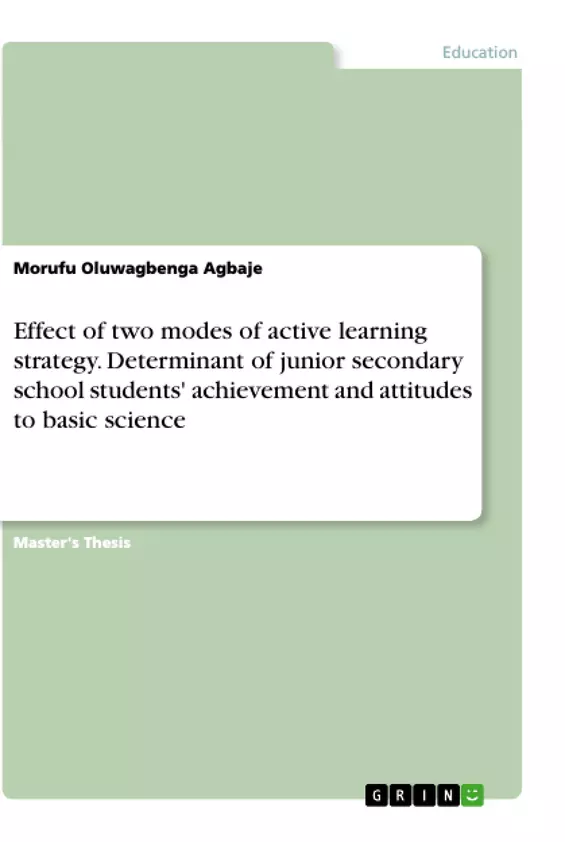This study examined the effect of two modes of active learning strategy as determinants of Junior Secondary School Students’ achievement and attitudes to Basic Science.
Science is a body of organized knowledge and a process of inquiry that is geared towards understanding nature in order to enhance the living standard of man. Many scientists define science according to their own perception and understanding of the subject matter. Bichi defines science as intellectual activities carried out by scientists designed to discover information about the natural world in which we live and to discover ways in which this information can be organized to benefit human race. In this respect, the primary focus of science is to collect data and the ultimate purpose is to discern order that exists in natural phenomena and happenings around us.
Inhaltsverzeichnis (Table of Contents)
- Chapter One: Introduction
- 1.1 Background to the Study
- 1.2 Statement of the Problem
- 1.3 Purpose of the Study
- 1.4 Research Questions
- 1.5 Significance of the Study
- 1.6 Scope of the Study
- 1.7 Limitations of the Study
- 1.8 Definition of Terms
- Chapter Two: Literature Review
- 2.1 Concept of Active Learning Strategy
- 2.2 Theoretical Framework
- 2.3 Active Learning Strategies and Students' Achievement
- 2.4 Active Learning Strategies and Students' Attitudes
- 2.5 Active Learning Strategies in Basic Science
- 2.6 Empirical Studies on Active Learning Strategies
- 2.7 Summary of Literature Review
- Chapter Three: Research Methodology
- 3.1 Research Design
- 3.2 Population of the Study
- 3.3 Sample and Sampling Techniques
- 3.4 Instrument for Data Collection
- 3.5 Validity and Reliability of Instruments
- 3.6 Method of Data Collection
- 3.7 Method of Data Analysis
- Chapter Four: Presentation and Analysis of Data
- 4.1 Research Hypotheses
- 4.2 Data Analysis
- 4.3 Test of Hypothesis
- Chapter Five: Discussion of Findings, Conclusion and Recommendations
Zielsetzung und Themenschwerpunkte (Objectives and Key Themes)
This dissertation investigates the impact of two active learning strategies on junior secondary school students' academic achievement and attitudes towards basic science. It compares the effectiveness of Think-Pair-Share and Minute Papers against the traditional lecture method.
- The effectiveness of active learning strategies in improving student achievement in basic science.
- The influence of active learning strategies on students' attitudes towards basic science.
- The relative effectiveness of different active learning methods (Think-Pair-Share, Minute Papers) compared to traditional lecture methods.
- The impact of gender on students' achievement in basic science.
- The interaction between teaching methods and gender on student achievement.
Zusammenfassung der Kapitel (Chapter Summaries)
Chapter One provides an overview of the study's background, problem statement, purpose, research questions, significance, scope, limitations, and definition of terms. It establishes the context for the research and highlights its relevance to the field of science education.
Chapter Two presents a comprehensive review of relevant literature on active learning strategies, their impact on student achievement and attitudes, and their application in basic science. It explores theoretical frameworks and empirical findings from previous studies.
Chapter Three outlines the research methodology employed in the study, including the research design, population, sample, instruments, validity and reliability, data collection procedures, and data analysis techniques. It provides a detailed description of the study's approach to collecting and analyzing data.
Chapter Four presents the results of the data analysis, including the testing of hypotheses and the interpretation of findings. It provides evidence-based insights into the relationship between active learning strategies and student outcomes.
Schlüsselwörter (Keywords)
The primary keywords and focus topics of this dissertation include active learning strategies, student achievement, attitudes towards basic science, Think-Pair-Share, Minute Papers, traditional lecture method, basic science education, junior secondary school students, research methodology, data analysis, and educational interventions.
- Quote paper
- Morufu Oluwagbenga Agbaje (Author), 2021, Effect of two modes of active learning strategy. Determinant of junior secondary school students' achievement and attitudes to basic science, Munich, GRIN Verlag, https://www.grin.com/document/1032010



